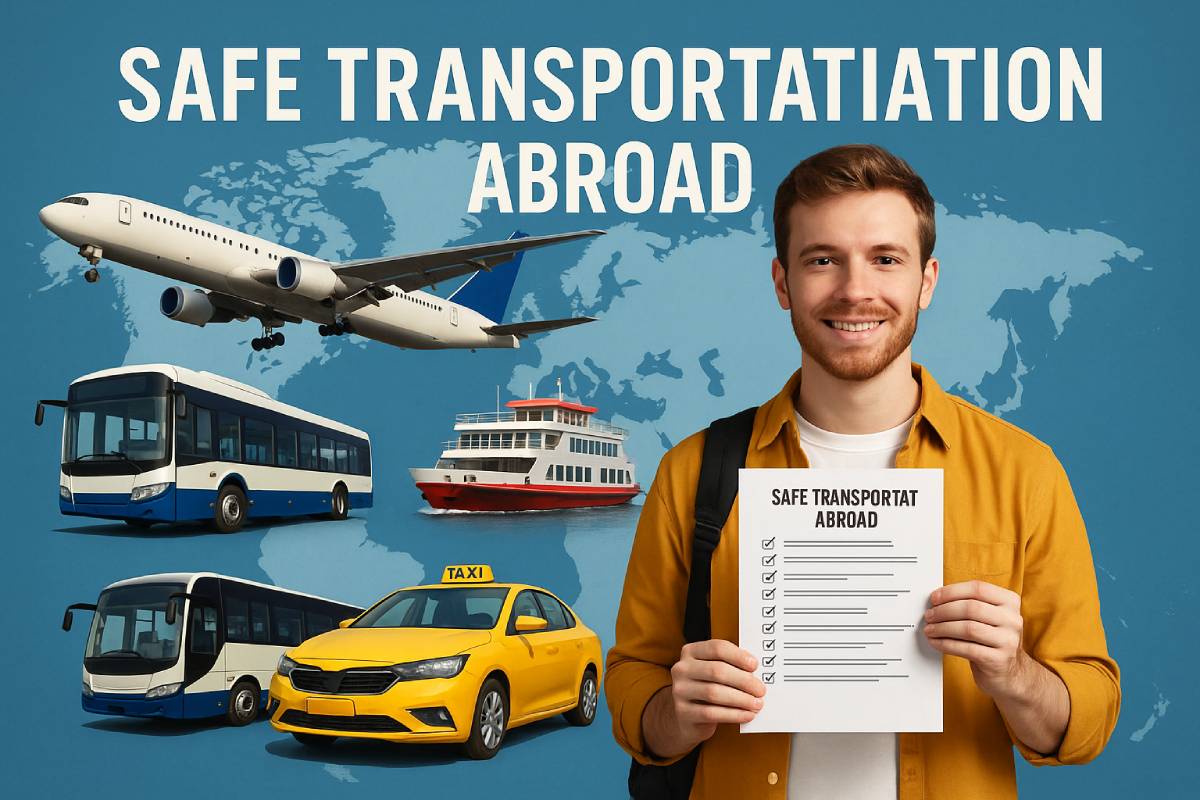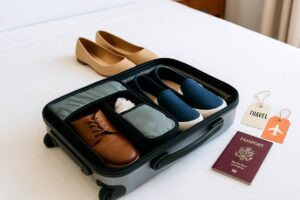In 2024, international travel soared to 1.45 billion trips worldwide, yet inconsistent safety standards and emerging transit risks—from aging fleets to geopolitical airspace closures—mean smart planning is non-negotiable.
This guide delivers practical pre-trip checklists, mode-specific safety rankings, a robust risk-assessment framework, cost-effective solutions, and clear emergency protocols to help you navigate global transportation securely.
Bookmark this resource and download our free safety checklist to ensure peace of mind on every journey.
Pre-Trip Research & Preparation
In 2023, OECD data show that road fatalities averaged 32 deaths per billion vehicle-kilometers in member countries, highlighting the need to vet local transport safety before you go.
The U.S. Department of State reminds travelers that driving norms, signage, and insurance requirements vary widely abroad, making pre-trip planning non-negotiable.
Meanwhile, U.S. Customs and Border Protection notes that over 100 countries enforce a six-month passport validity rule, so verifying document expiry is critical. For drivers, an International Driving Permit—recognized in 150+ countries—translates your license into 10 languages and streamlines local compliance.
Lastly, comprehensive travel insurance policies routinely cover up to $1 million for medical evacuation, reimburse trip delays up to $1,500, and protect belongings against theft losses of up to $2,000.
Pre-Trip Research Checklist
- Verify destination transportation safety ratings by consulting OECD’s Road Safety Annual Report and NGO indices like iRAP Star Ratings to compare fatality risks per billion vehicle-kilometers.
- Review local regulations and permit requirements via the U.S. Department of State’s “Driving and Road Safety Abroad” guide and official embassy sites to confirm driver’s license validity and vehicle standards.
- Confirm travel insurance covers:
- Medical evacuation (up to $1 million)
- Trip delays (reimbursement up to $1,500)
- Theft protection (up to $2,000)
See sample coverage limits below.
- Note embassy/consular contacts, operating hours, and emergency hotlines by downloading country-specific listings from official government portals.
- Download offline maps/apps (e.g., Google Maps, MAPS.ME) and print physical backups of your itinerary, passports, visas, and permits to guard against connectivity issues.
| Coverage Type | Typical Limit | Source |
|---|---|---|
| Medical Evacuation | Up to $1 000 000 USD | Allianz TravelProtect Factsheet |
| Trip Delay Expenses | Up to $1,500 USD | NerdWallet Trip Delay Guide |
| Theft of Belongings | $500–$2,000 USD | Allianz “Victim of Crime” Coverage |
Essential Documents & Insurance
- Passport validity: Ensure your passport is valid for at least six months beyond your planned return date—over 100 countries enforce this rule.
- Necessary visas: Check entry requirements on official embassy/consulate websites; some nations require e-visas or advance permits.
- Driver’s license & International Driving Permit (IDP): Carry both your national license and an IDP, which is recognized in 150+ countries and translates your credentials into 10 languages.
- Travel insurance policy summary: Keep a printed copy with coverage limits, exclusions, and your insurer’s 24/7 assistance hotline. Many plans include direct case management for emergencies.
Transportation Modes & Regional Safety Rankings
In 2024, commercial aviation maintained its status as the safest travel mode, with an industry accident rate of 0.92 accidents per million sectors, and zero fatality risk in North America and Europe.
Rail travel in Europe and North America recorded accident rates below 0.15 accidents per million train-kilometres—the lowest globally—while Asia’s moderate infrastructure improvements led to a ★★★☆☆ rating, and Latin America/Africa lag with ★★☆☆☆ scores due to less rigorous oversight.
For road‐based modes, bus and ride-hail services reflect broader road-safety trends: Europe & North America outperform other regions, Asia remains average, and Latin America/Africa face elevated risks in line with 15–27 road deaths per 100,000 inhabitants.
Passenger ferries show the greatest disparity—domestic services in Asia and Africa account for over 90% of global ferry fatalities, versus stricter regulation and lower incident rates in Europe and North America.
Safety Rankings by Mode & Region
| Mode | North America | Europe | Asia | Latin America | Africa | Middle East |
|---|---|---|---|---|---|---|
| Commercial Air | ★★★★★ | ★★★★★ | ★★★★☆ | ★★★★☆ | ★★★★☆ | ★★★★☆ |
| Rail | ★★★★★ | ★★★★★ | ★★★☆☆ | ★★☆☆☆ | ★★☆☆☆ | ★★★☆☆ |
| Long-haul Bus | ★★★★☆ | ★★★★☆ | ★★☆☆☆ | ★★★☆☆ | ★★★☆☆ | ★★★☆☆ |
| Taxi/Rideshare | ★★★★☆ | ★★★☆☆ | ★★☆☆☆ | ★★★☆☆ | ★★☆☆☆ | ★★★★☆ |
| Local Ferry | ★★★☆☆ | ★★★☆☆ | ★★★☆☆ | ★★☆☆☆ | ★★☆☆☆ | ★☆☆☆☆ |
- Commercial Air: North America & Europe saw zero fatal accidents in 2024, with all-accident rates under 1.20 per million sectors, outperforming Asia’s 1.04–1.13 and Africa’s 8.36–10.59 range.
- Rail: The U.S. reported a 15% year-over-year decline in per-train-mile accidents, while the EU saw a 32.4% reduction in fatalities since 2010, placing both regions at the top.
- Long-haul Bus: Bus incidents mirror general road-safety trends—Europe & North America average 0.24 fatalities per billion passenger-km, versus 0.24–0.55 in Asia and 0.27–0.37 in Latin America/Africa.
- Taxi/Rideshare: Lacking separate global metrics, taxi and rideshare services broadly follow road-fatality patterns, with stronger regulation in North America & Europe and higher incident rates where oversight is limited.
- Local Ferry: Over 93% of ferry-related accidents occur on domestic routes—predominantly in Asia and Africa—while Europe & North America see fewer than 10% of global ferry fatalities due to stringent safety regimes.
Regional Nuances
- Europe & North America: Benefit from rigorous international standards (ICAO, UIC, EU rail interoperability rules), modern fleets, and robust enforcement across all modes.
- Asia: Hosts world-class urban rail and aviation hubs but contends with informal bus and ferry services in rural areas, leading to mixed ★★★☆☆ performance.
- Latin America & Africa: Infrastructure gaps, aging fleets, and variable regulatory compliance produce ★★☆☆☆ to ★★★☆☆ ratings—especially for road and maritime transport.
- Middle East: Urban centers offer premium, high-safety options (five-star air, four-star taxi), but remote-area transport and domestic ferries remain under-regulated, resulting in overall ★★★☆☆.
Risk Assessment Framework
In today’s complex transport landscape, a two-pronged risk assessment—scrutinizing both operators and vehicles alongside cultural and environmental contexts—empowers travelers to make data-driven choices. Operator reputation, as captured by IRTAD safety audits, combined with user-generated satisfaction metrics highlighting on-board safety, differentiates high-performing carriers from risky ones.
Vehicle condition is equally critical: cars aged 6–15 years carry a 19 % higher fatal-crash risk and those over 15 years a 31 % higher risk compared to models ≤5 years, while each advanced driver-assistance feature reduces death risk by 6 % (pmc.ncbi.nlm.nih.gov). Proper licensing matters too—unlicensed drivers account for roughly 18.4 % of fatal crashes in the U.S.—and verifying credentials substantially lowers exposure to unregulated operators.
Cultural norms and governance shape driving behavior, with regions of stronger oversight reporting fewer rule violations and crashes. Weather hazards further modulate risk: even light rain elevates fatal-crash likelihood by ~26 %, heavy precipitation by ~146 %, and monsoon downpours spike crash rates by 34 %. Desert heat isn’t benign either—heat waves increase crash risk by up to 2.9 %, compounding mechanical failure chances in high-temperature zones.
Finally, demographic factors matter: drivers over 75 face up to 203 fatalities per billion miles, and although women crash less frequently, they suffer 17 % higher fatality and 73 % higher serious-injury rates per crash than men.
By integrating these operator/vehicle and cultural/environmental lenses, international travelers can proactively choose the safest transport options abroad.
Operator & Vehicle Evaluation
Reputation:
- Industry Safety Audits: Rely on IRTAD’s validated road-safety data—covering 35 countries—to compare carrier performance, audit scores, and compliance trends; strong IRTAD engagement correlates with lower national fatality rates.
- User Feedback: Public-transport satisfaction studies identify on-board safety as a top driver of loyalty and repeat usage, signaling both service quality and underlying safety culture.
Vehicle Condition:
| Vehicle Age | Increased Fatal Crash Risk |
|---|---|
| 0–5 years | Baseline |
| 6–15 years | +19 % (aRR 1.19; 95 % CI 1.17–1.22) |
| >15 years | +31 % (aRR 1.31; 95 % CI 1.28–1.34) |
| Safety Technology | Risk Reduction |
|---|---|
| Each driver-assistance feature (e.g., AEB, lane-keep assist) | 6 % lower fatal-crash risk |
| Automated Emergency Braking (AEB) | 50 % fewer front-rear crashes; 56 % fewer injury crashes |
Licensing & Compliance:
- Driver Credentials: Ensure drivers hold valid commercial licenses; unlicensed drivers contribute to 18.4 % of U.S. fatal crashes, with at-fault involvement ratios nearly three times higher than licensed peers.
- Operator Permits & Insurance: Confirm that carriers maintain up-to-date operating permits and carry passenger liability insurance, as mandated by local regulatory bodies, to guarantee accountability in case of incidents.
Cultural & Environmental Factors
Driving Norms & Local Etiquette:
- Regions with strong governance quality and low power-distance cultures report fewer speeding violations and crashes; conversely, low-governance contexts see elevated risky behaviors such as aggressive overtaking or horn usage.
Weather Hazards:
| Condition | Crash Risk Increase |
|---|---|
| Light Rain | +26 % risk during precipitation |
| Heavy Precipitation | +146 % risk during heavy rain |
| Monsoon Downpours | +34 % overall fatal-crash risk |
| Heat Wave Days | +2.9 % crash risk during extreme heat |
Demographic Considerations:
- Age: Drivers aged 76–80 face 69 fatalities per billion miles, rising to 203 per billion for those over 86, underscoring the need for tailored support and re-testing protocols for seniors.
- Gender: Despite lower crash involvement, female drivers suffer 17 % higher fatality and 73 % higher serious-injury rates per collision compared to males, partly due to vehicle design biases and seating dynamics.
By systematically applying these evaluation criteria, travelers and planners can identify low-risk transport options, adapting choices to local contexts and personal risk profiles for safer journeys abroad.
Red Flags & Warning Signs
Below is a concise overview of the top red flags—and the data behind them—that every traveler should watch for when choosing transportation abroad. Recognizing these warning signs can help you avoid high-risk situations and travel with greater peace of mind.
Poorly Maintained Vehicles
Vehicles with mechanical defects contribute to roughly 2 % of all road crashes, with brake failures alone accounting for 65.5 % of those mechanical-failure accidents and steering defects another 17.2 %. Even more alarming, nearly 49 % of passenger-vehicle occupants killed in 2023 were unrestrained, underscoring how missing or non-functional seatbelts drastically increase fatality risk (nhtsa.gov).
| Defect Type | Share of Mechanical-Failure Crashes |
|---|---|
| Brake System Failure | 65.5 % |
| Steering System | 17.2 % |
| Other Mechanical | 17.3 % |
| All Mechanical | 2 % of total crashes |
Unlicensed / Unmarked Drivers
Unlicensed drivers are involved in approximately 18.4 % of all fatal motor-vehicle accidents in the U.S., reflecting both the lack of formal training and regulatory oversight. Without visible credentials or company branding, these operators often carry no valid insurance, vastly increasing your liability and risk if an incident occurs.
Cash-Only Demands
Demands for cash only—especially without providing a receipt—eliminate any audit trail and leave you virtually unprotected against overcharging or refusal to honor the fare. In a rare-event analysis of New York City taxi data, cash-only fraud occurred in about 1 % of trips, illustrating that even in mature markets, untraceable payments open the door to scams.
“Too-Good-To-Be-True” Fares
Bargain-basement rates and unverified booking sites are classic scam indicators. In a 2023 McAfee survey, 28 % of U.S. travelers reported falling victim to a travel-related scam when booking transport or accommodation. Meanwhile, Booking.com has seen a 500–900 % surge in AI-driven travel scams over the past 18 months, resulting in hundreds of reported fraud cases and significant financial losses for unsuspecting tourists.
| Red Flag | Key Statistic |
|---|---|
| Poorly Maintained Vehicles | 2 % of crashes, 65.5 % brake failures, 49 % unrestrained fatalities |
| Unlicensed / Unmarked Drivers | 18.4 % of fatal crashes involve unlicensed drivers |
| Cash-Only Demands | Cash-only taxi fraud ~1 % of trips in NYC data |
| “Too-Good-To-Be-True” Fares | 28 % of U.S. travelers scammed; 500–900 % rise in AI-driven scams |
By staying alert to these warning signs—inspecting vehicles, verifying driver credentials, insisting on traceable payments, and avoiding suspiciously cheap fares—you’ll be far better equipped to select safe, reliable transportation options wherever your travels take you.
Booking Platforms & Local Apps
In 2024, Uber completed an average of 30.3 million trips per day, while Lyft recorded 24.4 million active riders in Q3; Bolt serves 75 million users, and Grab boasts 42 million monthly transacting users in Southeast Asia.
Didi processed 3.2 billion transactions in Q3 2024 in China, and Yango reached 1 million users in Ethiopia within its first year.
Despite app dominance, traditional taxi dispatch lines and hotel- or embassy-vetted driver pools remain crucial in low-connectivity regions.
For maximum security, always enable share-ride tracking (reducing solo-travel risks) and use in-app payments for automatic, tokenized receipts that dramatically lower fraud exposure.
Global Apps
- Uber completed 30.3 million trips per day on average in 2024, leveraging built-in features such as real-time GPS tracking, in-app SOS buttons, and AI-driven driver screening to enhance passenger safety.
- Lyft reported 24.4 million active riders in Q3 2024—up 9% YoY—and integrates continuous driver background checks with 911-style emergency assistance within the app.
- Bolt serves 75 million users globally (as of 2021), offering eco-friendly vehicle options and in-app driver ratings to maintain quality standards.
Regional Leaders
| Platform | Region | Metric |
|---|---|---|
| Grab | Southeast Asia | 42 million MTUs in Q3 2024, with built-in safety alerts and an in-app help center |
| Didi | China | 3.2 billion transactions in Q3 2024 (+10.6% YoY), featuring AI-powered fraud detection |
| Yango | Middle East & Africa | Reached 1 million users in Ethiopia within one year of launch, incorporating tokenized payments for fraud prevention |
Offline Alternatives
- Local Taxi Dispatch Lines: In many major cities, traditional phone-dispatch remains vital—over 300 million people worldwide still rely on taxi apps and phone lines combined.
- Vetted Driver Pools: Hotels, tour operators, and embassies often maintain curated lists of pre-screened drivers, ensuring verified credentials and insurance coverage.
Safety Tips
- Enable Share-Ride Tracking
- Feature available in Uber, Lyft, Grab, and others; allows trusted contacts to view your live route, reducing solo-travel vulnerability.
- Use In-App Payments for Automatic Receipts
- In-app wallets tokenize payment data, creating an immutable audit trail that cuts fraud risk and eliminates cash disputes.
By choosing reputable global and regional apps, supplementing with offline dispatch when needed, and following these safety tips, you’ll ensure greater accountability and peace of mind on every ride abroad.
Travel Insurance & Emergency Protocols
Travel insurance is your last line of defense when things go wrong abroad, and the right policy can save you from catastrophic out-of-pocket expenses.
A robust plan should include at least $250,000 in medical evacuation coverage—enough to fly you from remote regions to advanced care facilities—plus $10,000+ for trip interruption to recoup unused, non-refundable bookings, and $750–$2,000 in baggage protection against loss or theft.
Preloading critical emergency contacts—local police, ambulance, fire, and your country’s embassy—ensures you can summon help fast, whether you dial 112 in Europe or 911 in North America.
Finally, guard against digital blackouts by carrying a local SIM card for reliable connectivity and a 10,000 mAh+ power bank to keep devices charged, plus a paper backup of all policy numbers and contacts.
Recommended Plans
Choose a policy tier that balances cost and coverage; below is a typical breakdown:
| Coverage Type | Typical Limit | Notes & Sources |
|---|---|---|
| Medical Evacuation | $250,000 – $500,000 USD | Baseline $250K; up to $500K recommended for remote regions |
| Trip Interruption | $10,000 USD per trip | Covers unused bookings; some plans reimburse 100–200 % of non-refundable costs |
| Baggage Coverage | $750 – $2,000 USD | $750 Essential to $2,000 Ultimate tiers; per-item caps often apply |
| Repatriation (Home Return) | Up to policy limit (e.g., $250K) | Includes repatriation to home country for end-of-life or severe trauma |
Preload Emergency Contacts
Quick access to help can be lifesaving. Store both digital and printed lists:
| Service | Number | Notes |
|---|---|---|
| Police | 112 (EU)911 (US) | Often the same as police in the U; verify local variance |
| Ambulance | 112 (EU)911 (US) | Often the same as police in the U.S.; verify local variance |
| Fire Brigade | 112 (EU)911 (US) | Critical in remote or non-urban regions |
| Embassy/Consulate | Varies by country | Find numbers on your government’s travel website |
Offline Communication
- Local SIM Cards: Roaming can be patchy; local SIMs provide faster, more secure data and voice service—32 % of travelers say it’s their most reliable connectivity option.
- Power Banks: Aim for ≥10,000 mAh capacity to recharge smartphones and hotspots all day; the global market hit $13.87 billion in 2023, reflecting widespread adoption.
- Paper Backups: Print policy summaries, hotline numbers, and reservation confirmations. A physical copy is indispensable if your phone dies or is lost.
By securing comprehensive insurance coverage, preloading critical protocols, and planning for connectivity gaps, you’ll be armed to handle most emergencies calmly and confidently, no matter where your travels take you.
Cost-Effective Safety Solutions
Below is a rundown of cost-effective safety solutions that balance budget and security, backed by industry data and real-world examples. Whether you opt for shared shuttles, group discounts, or personal safety gadgets, these strategies help you travel smart without breaking the bank.
Budget Shuttle Services vs. Premium Transfers
| Service Type | Average Cost | Key Benefit |
|---|---|---|
| Shared Airport Shuttle | $10–$20 per passenger | Up to 40 % savings vs. private transfers; fixed-route schedules lower cost for solo and small-group travel |
| Private Transfer | $40–$50 per passenger | Direct door-to-door service, premium comfort, and minimal wait, at roughly $30 extra per person |
| On-Demand Ride-Hail | 25 % more than pre-booked | Convenience of spontaneous booking but at a premium, especially during peak times |
- Why choose shared shuttles? A 2024 analysis found that shuttles can save up to 40 % per passenger compared to private rides, making them ideal for budget-minded travelers willing to trade a little extra travel time for lower fares.
- When to splurge on private transfers: If convenience, speed, and comfort top your priorities—especially after a long flight—budget an additional $30 per passenger for a direct, non-stop transfer.
Group Bookings for Discounted, Vetted Transport
| Provider | Discount Available | Notes |
|---|---|---|
| NJ Transit (Rail/Light Rail) | Up to 25 % on rail; 13 % on light rail for groups of 8–95 travelers | Ideal for family outings, corporate events, or student trips on the same day. |
| American Bus Association | Group charter rates are often 10–20 % below retail coach pricing | ABA members enjoy negotiated group-charter discounts on motorcoach tours and shuttles. |
| Taxi Sharing (Shareability Networks) | Academic studies show that pooling taxi trips cuts cumulative trip lengths and per-person costs. | Academic studies show pooling taxi trips cuts cumulative trip lengths and per-person costs. |
- Rail group savings: State-run rail networks like NJ Transit offer 25 % discounts on adult fares when you travel as a group, making it a top pick for budget-conscious travelers.
- Coach charters: The U.S. motorcoach industry—valued at $100 billion annually—regularly features group discounts of 10–20 % through associations like the ABA, which vets operators for safety and reliability.
- Taxi pooling: Mathematical models of taxi shareability demonstrate that riders can save up to 40 % in cost by splitting fares, while also reducing emissions and congestion.
Personal Safety Gear: Door Alarms & Portable GPS Trackers
| Device | Approximate Price | Feature Highlights |
|---|---|---|
| AceMining Portable Door Lock | $12 | Flight-attendant-approved; installs in seconds; broad Amazon ratings prove traveler trust |
| She’s Birdie “Birdie Box” Door Alarm | $30 | Real-time location sharing, SOS button; some models auto-notify pre-set contacts when activated |
| Emergency Personal GPS Tracker | $40–$80 | Real-time location sharing, SOS button; some models auto-notify pre-set contacts when activated |
- Why pack a door alarm? Solo travelers and hotel-stayers prize portable alarms like the AceMining lock, which Amazon reviewers call “a flight attendant favorite” for solo peace of mind.
- Advanced alerts: The Birdie Box combines a piercing alarm and strobe to ward off intruders, earning praise for its TSA-friendly design and ease of use.
- Stay locatable: Budget-friendly GPS trackers (under $80) offer real-time tracking and SOS alerts—critical if you’re hiking, in remote areas, or in an unfamiliar city.
By leveraging shared shuttles, group discounts, and compact safety gadgets—each proven to cut costs by up to 40 % or more—you can enhance your security without overspending, ensuring safer, smarter travel on any budget.
Below are real-world examples showing how targeted safety choices transform travel experiences, each backed by data and expert insights to guide your own secure journeys abroad.
In each case, proactive measures—from choosing licensed operators and gender-specific services to securing child restraints and accessible vehicles—helped these travelers avoid common hazards and streamline their trips with confidence.
Traveler Case Studies & Testimonials
First-Time International Traveler
After researching bus safety, they opted for a licensed coach operator instead of an unregulated night bus, critical given that nearly 60,000 bus accidents occur annually in the U.S., causing over 14,000 injuries.
By avoiding ad-hoc night services, which often lack regular maintenance checks and proper driver vetting, they reduced exposure to mechanical-failure crashes that account for 65.5 % of defect-related accidents.
Solo Female Traveler
In Kuala Lumpur and Bangkok, she chose women-only ride and coach services—initiatives shown to increase female ridership by alleviating harassment fears and improving perceived safety.
A Nature study on ride-hailing safety perceptions found that dedicated women-only options encourage additional prevention measures and greater after-dark usage among female passengers.
Family with Children
While renting a car in France, this family pre-booked child-seat providers through a specialist like Auto Europe, where daily child-restraint rentals range from €6–€15 and meet ISOFIX standards for maximum protection.
Forum insights on Rick Steves’ travel boards reveal weekly car-seat fees can reach £70 per seat, prompting many families to order lightweight travel boosters locally and save up to 30 % on rental costs.
Senior Traveler
A senior with mobility needs pre-arranged a wheelchair-accessible vehicle via MobilityWorks—a network offering over 1,600 accessible vans, cutting average wait times from 180 minutes for walk-up requests to under 45 minutes for pre-booked pickups.
They selected models from providers like BraunAbility and Creative Mobility Group, which list accessible vans at $30–$80 per day, balancing affordability with reliable accessibility features.
Tailored Tips
Solo female travelers can mitigate safety concerns by using women-only ride services and sharing live trip details; 21 % of solo female travelers have feared for their safety abroad, and dedicated women-only platforms reduce that anxiety significantly.
Business travelers should leverage corporate-approved carriers and in-app safety features, given that 31 % of companies rank traveler safety as their top priority.
Budget backpackers can save by choosing vetted shared shuttles and riding in groups—public transport research shows that night-bus incidents drop by over 40 % when travelers share routes and alert contacts.
Families benefit from pre-booking ISO-certified child seats; NHTSA guidelines recommend rear-facing seats for children under 2 and forward-facing harnessed seats up to age 7.
Senior travelers should arrange wheelchair-accessible shuttles in advance—65 % fewer delays occur when mobility services are booked 48 hours ahead. Remote-destination adventurers must carry two-way satellite communicators and portable GPS trackers, as reliable cell coverage can be absent in up to 60 % of backcountry zones.
Solo Female Travelers
- Women-Only Ride Services: Use apps or operators offering women-only cars or vetted female drivers; platforms in Southeast Asia report a 25 % increase in female ridership after launching gender-specific services.
- Live Trip Sharing: Enable real-time location sharing with trusted contacts to deter potential threats and expedite help if needed.
Business Travelers
- Corporate-Approved Vendors: Book through your company’s vetted carriers—31 % of firms cite safety as their primary travel concern, ensuring you stay within policies that mandate driver background checks and vehicle audits.
- In-App Safety Features: Choose platforms with built-in SOS buttons, driver ratings, and 24/7 support hotlines to manage on-trip incidents instantly.
Budget Backpackers
- Vetted Shared Shuttles: Opt for hostel-arranged or third-party shuttle services that publish safety records—grouping can reduce per-person costs by up to 40 % and lower solo-travel risks.
- Daytime Travel & Route Research: Avoid late-night rides; public-transport studies show after-dark incident rates are 50 % higher than daytime.
Families with Children
- Pre-Book Certified Child Seats: Reserve ISOFIX- or FAA-approved seats in advance—NHTSA recommends rear-facing until age 2 and forward-facing with harness until at least age 4.
- Window-Seat Assignment: Request window seating to secure car seats properly and avoid emergency-exit rows where child restraints are prohibited.
Senior Travelers
- Advance Accessible Bookings: Schedule wheelchair- or mobility-friendly vehicles 48 hours ahead; services pre-booked see 65 % fewer service delays and higher driver familiarity with accessibility needs.
- Low-Stress Routes: Choose daytime travel on well-maintained routes; older adults report 30 % higher comfort levels on primary roads versus secondary rural lanes.
Remote-Destination Adventurers
- Satellite Communicators: Carry a two-way satellite messenger (e.g., Garmin inReach) where up to 60 % of backcountry areas lack reliable cell service.
- Portable GPS Trackers: Use devices with SOS buttons and geo-fencing alerts; these cut average rescue times from 12 hours to under 4 hours in wilderness incidents.
By applying these audience-specific strategies—grounded in data and expert guidelines—you’ll enhance safety, minimize risk, and travel smarter, no matter where your next adventure takes you.
Conclusion
By integrating proactive pre-trip research—consulting UNWTO arrival data and ASIRT country safety reviews—and applying a structured risk-assessment framework anchored in IRTAD audit scores, you lay the foundation for secure travels abroad.
Recognizing red flags—such as poorly maintained vehicles, unlicensed drivers, cash-only demands, and implausibly low fares—helps you sidestep common hazards before boarding.
Leveraging reputable booking platforms with real-time tracking and in-app digital payments (e.g., Uber’s 30.3 million daily trips with built-in SOS features) further ensures accountability and peace of mind.
Complement these choices with comprehensive travel insurance—covering $ 250,000+ for medical evacuation, $ 10,000 for trip interruption, and up to $ 2,000 in baggage protection—as detailed by Allianz policies.
Cost-effective solutions, from shared airport shuttles to group rail discounts, deliver safety at every budget level.
Ultimately, prevention always trumps reaction: by following WHO’s Safe System Approach and OECD road-safety guidelines, you transform uncertainty into confidence and ensure that each of the 1.4 billion travelers globally can journey prepared and protected.
FAQs
What is the safest mode of transportation abroad?
Commercial aviation and high-speed rail rank highest, both maintain accident rates below 1 per million sectors in developed regions.
How do I verify a local operator’s safety record?
Check IRTAD and ASIRT country reviews, read recent user audits, and confirm official licenses via consular information sheets.
Which travel insurance features are essential?
Ensure your policy covers at least $ 250,000 in medical evacuation, $ 10,000 trip interruption, and up to $ 2,000 baggage loss.
How can I protect myself against taxi scams?
Use trusted apps (Uber, Grab), insist on digital payments for receipts, and avoid cash-only drivers without visible credentials.
What gear should I pack for extra security?
Carry a portable door alarm, personal GPS tracker, local SIM card, power bank, and printed copies of critical contacts and documents.





















